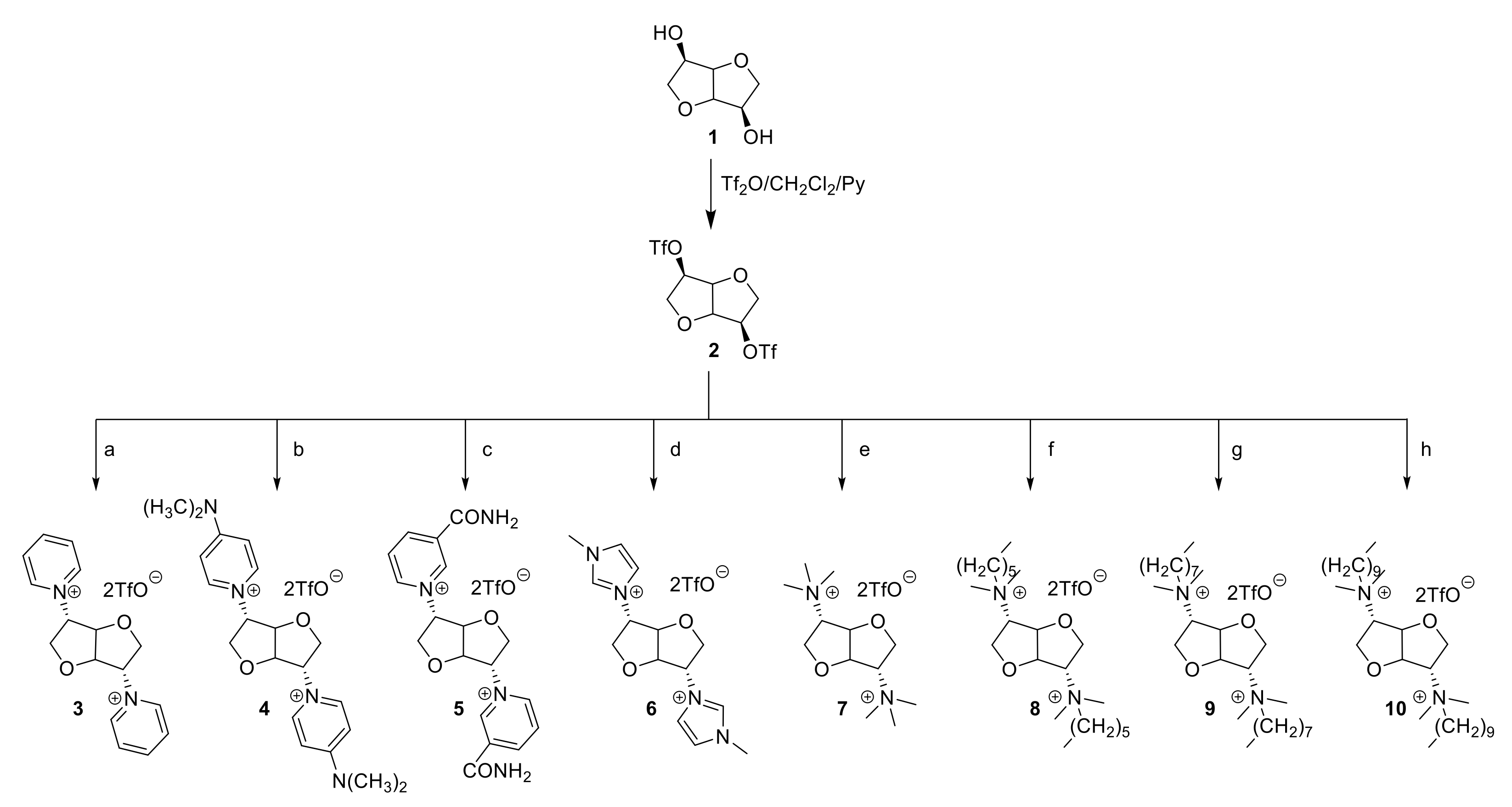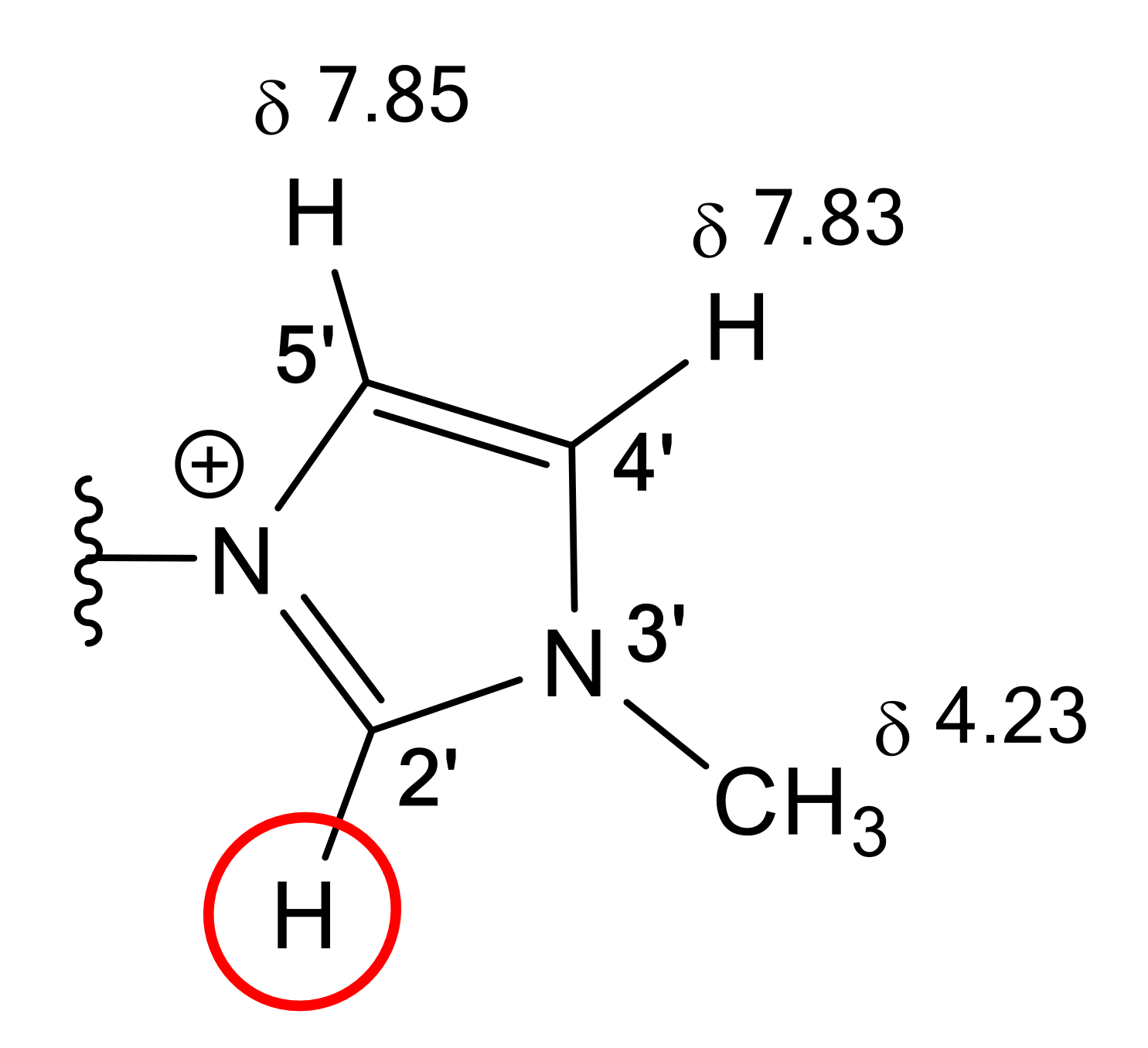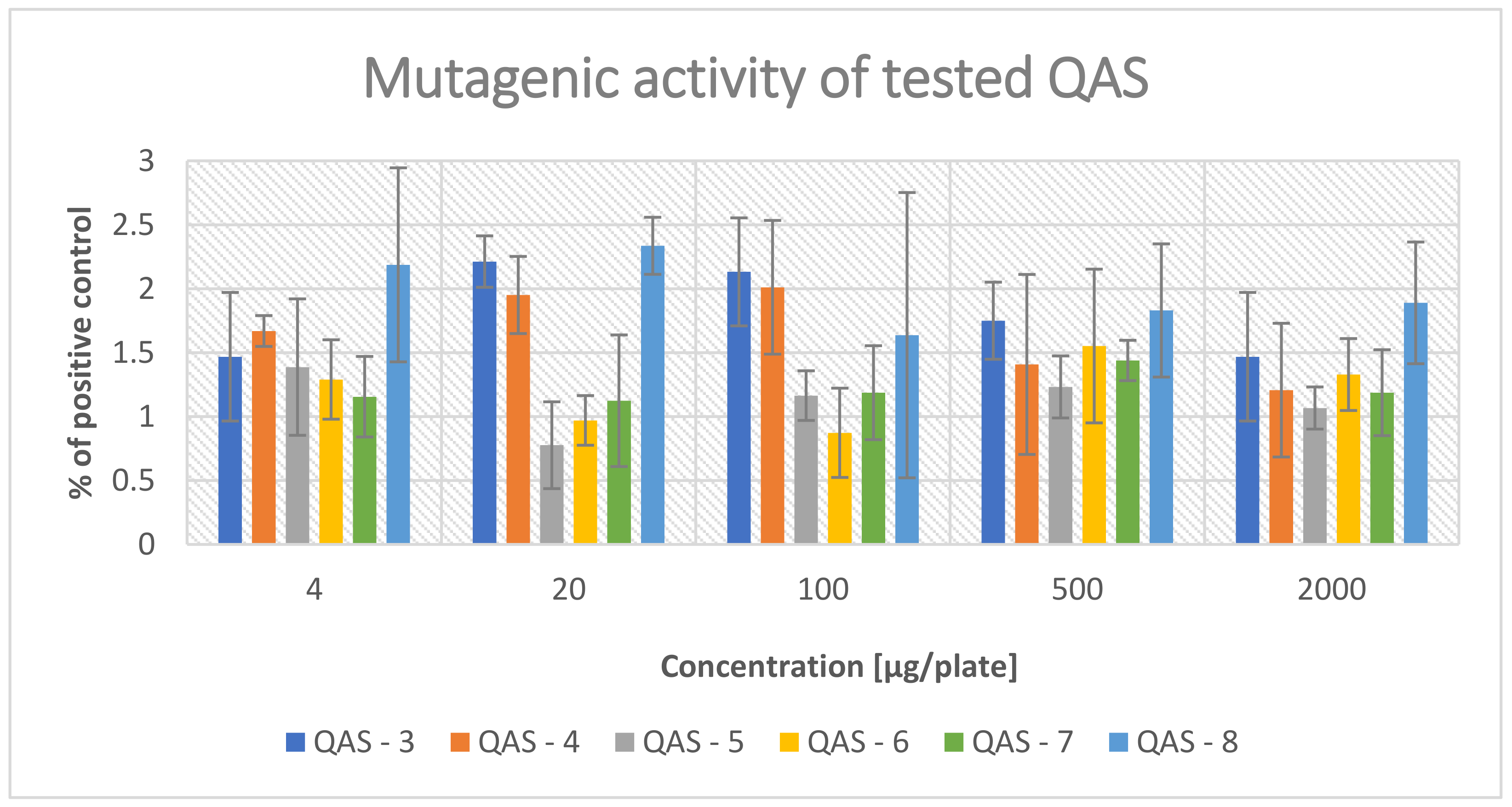Antimicrobial, Cytotoxic and Mutagenic Activity of Gemini QAS Derivatives of 1,4:3,6-Dianhydro-l-iditol
Abstract
:1. Introduction
2. Results and Discussion
2.1. Chemistry
2.2. Antimicrobial Activity
2.3. Mutagenic Activity
3. Materials and Methods
3.1. Synthesis
3.1.1. General Information
3.1.2. N,N’-(1,4:3,6-Dianhydro-2,5-dideoxy-l-iditol-2,5-diyl)-bis[(3-carboxamide)pyridinium] Ditrifluoromethanesulfonate (5)
3.1.3. N,N’-(1,4:3,6-Dianhydro-2,5-dideoxy-l-iditol-2,5-diyl)-bis(N-methylimidazolium) Ditrifluoromethanesulfonate (6)
3.1.4. N,N’-(1,4:3,6-Dianhydro-2,5-dideoxy-l-iditol-2,5-diyl)-bis(N,N-dimethyl-N-hexylammonium) Ditrifluoromethanesulfonate (8)
3.1.5. N,N’-(1,4:3,6-Dianhydro-2,5-dideoxy-l-iditol-2,5-diyl)-bis(N,N-dimethyl-N-decylammonium) Ditrifluoromethanesulfonate (10)
3.2. Antimicrobial Activity
3.3. Toxicity—MTT Assay
3.4. Mutagenic Assay—The Ames Test
4. Conclusions
Supplementary Materials
Author Contributions
Funding
Institutional Review Board Statement
Informed Consent Statement
Data Availability Statement
Acknowledgments
Conflicts of Interest
References
- Pang, J.; Wang, A.; Zheng, M.; Zhang, Y.; Huang, Y.; Chen, X.; Zhang, T. Catalytic conversion of cellulose to hexitols with mesoporous carbon supported Ni-based bimetallic catalysts. Green Chem. 2012, 14, 614–617. [Google Scholar] [CrossRef]
- Liu, Y.; Chen, L.; Wang, T.; Xu, Y.; Zhang, Q.; Ma, L.; Liao, Y.; Shi, N. Direct conversion of cellulose into C 6 alditols over Ru/C combined with H + -released boron phosphate in an aqueous phase. RSC Adv. 2014, 4, 52402–52409. [Google Scholar] [CrossRef]
- Luo, Y.; Li, Z.; Li, X.; Liu, X.; Fan, J.; Clark, J.H.; Hu, C. The production of furfural directly from hemicellulose in lignocellulosic biomass: A review. Catal. Today 2019, 319, 14–24. [Google Scholar] [CrossRef]
- Graham, J.C. Role of aminoglycosides in the treatment of bacterial endocarditis. J. Antimicrob. Chemother. 2002, 49, 437–444. [Google Scholar] [CrossRef] [PubMed] [Green Version]
- Boukerb, A.M.; Rousset, A.; Galanos, N.; Méar, J.; Thepaut, M.; Grandjean, T.; Gillon, E.; Cecioni, S.; Abderrahmen, C.; Faure, K.; et al. Anti-adhesive properties of glycoclusters against Pseudomonas aeruginosa lung infection. J. Med. Chem. 2014, 57, 10275–10289. [Google Scholar] [CrossRef]
- Pashkuleva, I.; Reis, R.L. Sugars: Burden or biomaterials of the future? J. Mater. Chem. 2010, 20, 8803–8818. [Google Scholar] [CrossRef] [Green Version]
- Varki, A. Biological roles of glycans. Glycobiology 2017, 27, 3–49. [Google Scholar] [CrossRef] [Green Version]
- Obłąk, E.; Piecuch, A.; Rewak-Soroczyńska, J.; Paluch, E. Activity of gemini quaternary ammonium salts against microorganisms. Appl. Microbiol. Biotechnol. 2019, 103, 625–632. [Google Scholar] [CrossRef]
- Ioannou, C.J.; Hanlon, G.W.; Denyer, S.P. Action of disinfectant quaternary ammonium compounds against Staphylococcus aureus. Antimicrob. Agents Chemother. 2007, 51, 296–306. [Google Scholar] [CrossRef] [Green Version]
- Tischer, M.; Pradel, G.; Ohlsen, K.; Holzgrabe, U. Quaternary ammonium salts and their antimicrobial potential: Targets or nonspecific interactions? ChemMedChem 2012, 7, 22–31. [Google Scholar] [CrossRef]
- Prat, M.; Fernández, D.; Buil, M.A.; Crespo, M.I.; Casals, G.; Ferrer, M.; Tort, L.; Castro, J.; Monleón, J.M.; Gavaldà, A.; et al. Discovery of Novel Quaternary Ammonium Derivatives of (3R)-Quinuclidinol Esters as Potent and Long-Acting Muscarinic Antagonists with Potential for Minimal Systemic Exposure after Inhaled Administration: Identification of (3R)-3-{[Hydroxy(di-2-thienyl). J. Med. Chem. 2009, 52, 5076–5092. [Google Scholar] [CrossRef] [PubMed]
- Hsu, L.-H.; Kwaśniewska, D.; Wang, S.; Shen, T.-L.; Wieczorek, D.; Chen, Y.-L. Gemini quaternary ammonium compound PMT12-BF4 inhibits Candida albicans via regulating iron homeostasis. Sci. Rep. 2020, 10, 2911. [Google Scholar] [CrossRef] [PubMed]
- Damen, M.; Groenen, A.J.J.; van Dongen, S.F.M.; Nolte, R.J.M.; Scholte, B.J.; Feiters, M.C. Transfection by cationic gemini lipids and surfactants. Medchemcomm 2018, 9, 1404–1425. [Google Scholar] [CrossRef] [PubMed]
- Carson, R.T.; Larson, E.; Levy, S.B.; Marshall, B.M.; Aiello, A.E. Use of antibacterial consumer products containing quaternary ammonium compounds and drug resistance in the community. J. Antimicrob. Chemother. 2008, 62, 1160–1162. [Google Scholar] [CrossRef] [PubMed] [Green Version]
- Pernak, J.; Niemczak, M.; Zakrocka, K.; Praczyk, T. Herbicidal ionic liquid with dual-function. Tetrahedron 2013, 69, 8132–8136. [Google Scholar] [CrossRef]
- Brycki, B.E.; Kowalczyk, I.H.; Szulc, A.; Kaczerewska, O.; Pakiet, M. Multifunctional Gemini Surfactants: Structure, Synthesis, Properties and Applications. In Application and Characterization of Surfactants; InTech: London, UK, 2017. [Google Scholar]
- Pakiet, M.; Tedim, J.; Kowalczyk, I.; Brycki, B. Functionalised novel gemini surfactants as corrosion inhibitors for mild steel in 50 mM NaCl: Experimental and theoretical insights. Colloids Surfaces A Physicochem. Eng. Asp. 2019, 580, 123699. [Google Scholar] [CrossRef]
- Gunaratne, H.Q.N.; Laaksonen, T.; Seddon, K.R.; Wähälä, K. 1-(1)-dehydroabietylimidazolium salts as enantiomer discriminators for NMR spectroscopy. Aust. J. Chem. 2017, 70, 845–856. [Google Scholar] [CrossRef] [Green Version]
- Jiang, J.; Mu, X.; Qiao, J.; Su, Y.; Qi, L. New chiral ligand exchange capillary electrophoresis system with chiral amino amide ionic liquids as ligands. Talanta 2017, 175, 451–456. [Google Scholar] [CrossRef]
- Jiang, T.; Gao, H.; Han, B.; Zhao, G.; Chang, Y.; Wu, W.; Gao, L.; Yang, G. Ionic liquid catalyzed Henry reactions. Tetrahedron Lett. 2004, 45, 2699–2701. [Google Scholar] [CrossRef]
- Coleman, D.; Gathergood, N. Biodegradation studies of ionic liquids. Chem. Soc. Rev. 2010, 39, 600–637. [Google Scholar] [CrossRef]
- Brycki, B.; Waligórska, M.; Szulc, A. The biodegradation of monomeric and dimeric alkylammonium surfactants. J. Hazard. Mater. 2014, 280, 797–815. [Google Scholar] [CrossRef] [PubMed]
- Grabińska-Sota, E. Genotoxicity and biodegradation of quaternary ammonium salts in aquatic environments. J. Hazard. Mater. 2011, 195, 182–187. [Google Scholar] [CrossRef] [PubMed]
- Zhang, C.; Cui, F.; Zeng, G.; Jiang, M.; Yang, Z.; Yu, Z.; Zhu, M.; Shen, L. Quaternary ammonium compounds (QACs): A review on occurrence, fate and toxicity in the environment. Sci. Total Environ. 2015, 518–519, 352–362. [Google Scholar] [CrossRef] [PubMed]
- Pateiro-Moure, M.; Arias-Estévez, M.; López-Periago, E.; Martínez-Carballo, E.; Simal-Gándara, J. Occurrence and downslope mobilization of quaternary herbicide residues in vineyard-devoted soils. Bull. Environ. Contam. Toxicol. 2008, 80, 407–411. [Google Scholar] [CrossRef] [PubMed]
- Ismail, Z.Z.; Tezel, U.; Pavlostathis, S.G. Sorption of quaternary ammonium compounds to municipal sludge. Water Res. 2010, 44, 2303–2313. [Google Scholar] [CrossRef]
- Ferk, F.; Mišík, M.; Hoelzl, C.; Uhl, M.; Fuerhacker, M.; Grillitsch, B.; Parzefall, W.; Nersesyan, A.; Mičieta, K.; Grummt, T.; et al. Benzalkonium chloride (BAC) and dimethyldioctadecyl-ammonium bromide (DDAB), two common quaternary ammonium compounds, cause genotoxic effects in mammalian and plant cells at environmentally relevant concentrations. Mutagenesis 2007, 22, 363–370. [Google Scholar] [CrossRef] [Green Version]
- Kwaśniewska, D.; Chen, Y.-L.; Wieczorek, D. Biological Activity of Quaternary Ammonium Salts and Their Derivatives. Pathogens 2020, 9, 459. [Google Scholar] [CrossRef]
- Zullo, V.; Górecki, M.; Guazzelli, L.; Mezzetta, A.; Pescitelli, G.; Iuliano, A. Exploiting isohexide scaffolds for the preparation of chiral ionic liquids tweezers. J. Mol. Liq. 2021, 322, 114528. [Google Scholar] [CrossRef]
- Zullo, V.; Iuliano, A.; Guazzelli, L. Sugar-Based Ionic Liquids: Multifaceted Challenges and Intriguing Potential. Molecules 2021, 26, 2052. [Google Scholar] [CrossRef]
- Erfurt, K.; Markiewicz, M.; Siewniak, A.; Lisicki, D.; Zalewski, M.; Stolte, S.; Chrobok, A. Biodegradable Surface Active D-Glucose Based Quaternary Ammonium Ionic Liquids in the Solventless Synthesis of Chloroprene. ACS Sustain. Chem. Eng. 2020, 8, 10911–10919. [Google Scholar] [CrossRef]
- Gaida, B.; Brzęczek-Szafran, A. Insights into the Properties and Potential Applications of Renewable Carbohydrate-Based Ionic Liquids: A Review. Molecules 2020, 25, 3285. [Google Scholar] [CrossRef] [PubMed]
- Cohen, J.I.; Castro, S.; Han, J.A.; Behaj, V.; Engel, R. Polycations. IX. Polyammonium derivatives of cyclodextrins: Syntheses and binding to organic oxyanions. Heteroat. Chem. 2000, 11, 546–555. [Google Scholar] [CrossRef]
- Thomas, M.; Montenegro, D.; Castaño, A.; Friedman, L.; Leb, J.; Huang, M.L.; Rothman, L.; Lee, H.; Capodiferro, C.; Ambinder, D.; et al. Polycations. 17. Synthesis and properties of polycationic derivatives of carbohydrates. Carbohydr. Res. 2009, 344, 1620–1627. [Google Scholar] [CrossRef] [PubMed]
- Abel, T.; Cohen, J.I.; Engel, R.; Filshtinskaya, M.; Melkonian, A.; Melkonian, K. Preparation and investigation of antibacterial carbohydrate-based surfaces. Carbohydr. Res. 2002, 337, 2495–2499. [Google Scholar] [CrossRef]
- Engel, R.; Ghan, I.; Montenegro, D.; Thomas, M.; Klaritch-Vrana, B.; Castano, A.; Friedman, L.; Leb, J.; Rothman, L.; Lee, H.; et al. Polycationic glycosides. Molecules 2011, 16, 1508–1518. [Google Scholar] [CrossRef] [Green Version]
- Wang, C.H.; Liu, W.S.; Sun, J.F.; Hou, G.G.; Chen, Q.; Cong, W.; Zhao, F. Non-toxic O-quaternized chitosan materials with better water solubility and antimicrobial function. Int. J. Biol. Macromol. 2016, 84, 418–427. [Google Scholar] [CrossRef]
- Shahid-ul-Islam; Butola, B.S. Recent advances in chitosan polysaccharide and its derivatives in antimicrobial modification of textile materials. Int. J. Biol. Macromol. 2019, 121, 905–912. [Google Scholar] [CrossRef]
- Song, J.; Liu, J.; Zhao, W.; Chen, Y.; Xiao, H.; Shi, X.; Liu, Y.; Chen, X. Quaternized Chitosan/PVA Aerogels for Reversible CO2 Capture from Ambient Air. Ind. Eng. Chem. Res. 2018, 57, 4941–4948. [Google Scholar] [CrossRef]
- Gomes da Silva, M.D.R.; Pereira, M.M. a New chiral imidazolium ionic liquids from isomannide. Carbohydr. Res. 2011, 346, 197–202. [Google Scholar] [CrossRef]
- Kumar, V.; Pei, C.; Olsen, C.E.; Schäffer, S.J.C.; Parmar, V.S.; Malhotra, S.V. Novel carbohydrate-based chiral ammonium ionic liquids derived from isomannide. Tetrahedron Asymmetry 2008, 19, 664–671. [Google Scholar] [CrossRef]
- Kumar, V.; Olsen, C.E.; Schäffer, S.J.C.; Parmar, V.S.; Malhotra, S. V Synthesis and Applications of Novel Bis(ammonium) Chiral Ionic Liquids Derived from Isomannide. Org. Lett. 2007, 9, 3905–3908. [Google Scholar] [CrossRef] [PubMed]
- Kumar, S.; Ramachandran, U. The synthesis and applications of asymmetric phase-transfer catalysts derived from isomannide and isosorbide. Tetrahedron 2005, 61, 4141–4148. [Google Scholar] [CrossRef]
- Sikora, K.; Nowacki, A.; Sikorski, A.; Dmochowska, B. The synthesis and structure of gemini QASs of 1,4:3,6-dianhydro-L-iditol. J. Mol. Struct. 2015, 1101, 228–235. [Google Scholar] [CrossRef]
- Dunn, G.E.; Lee, G.K.J.; Thimm, H. Kinetics and Mechanism of Decarboxylation of some Pyridinecarboxylic Acids in Aqueous Solution. Can. J. Chem. 1972, 50, 3017–3027. [Google Scholar] [CrossRef]
- Lin, S.T.; Ding, M.F.; Chang, C.W.; Lue, S.S. Nuclear magnetic resonance spectroscopic study on ionic liquids of 1-alkyl-3-methylimidazolium salts. Tetrahedron 2004, 60, 9441–9446. [Google Scholar] [CrossRef]
- Kamysz, W.; Turecka, K. Antimicrobial Preservative Effectiveness. Acta Pol. Pharm. ñ Drug Res. 2005, 62, 341–344. [Google Scholar]
- Bore, E.; Hébraud, M.; Chafsey, I.; Chambon, C.; Skjæret, C.; Moen, B.; Møretrø, T.; Langsrud, Ø.; Rudi, K.; Langsrud, S. Adapted tolerance to benzalkonium chloride in Escherichia coli K-12 studied by transcriptome and proteome analyses. Microbiology 2007, 153, 935–946. [Google Scholar] [CrossRef] [Green Version]
- Furi, L.; Ciusa, M.L.; Knight, D.; Di Lorenzo, V.; Tocci, N.; Cirasol, D.; Aragones, L.; Coelho, J.R.; Freitas, A.T.; Marchi, E.; et al. Evaluation of reduced susceptibility to quaternary ammonium compounds and bisbiguanides in clinical isolates and laboratory-generated mutants of staphylococcus aureus. Antimicrob. Agents Chemother. 2013, 57, 3488–3497. [Google Scholar] [CrossRef] [Green Version]
- OCED/OCDE. Test, No. 471: Bacterial Reverse Mutation Test. In OECD Guidelines for the Testing of Chemicals, Section 4; OECD: Paris, France, 2020; ISBN 9789264071247. [Google Scholar]
- Elder, R.L. Final report on the safety assessment of benzalkonium chloride. J. Am. Coll. Toxicol. 1989, 8, 589–625. [Google Scholar] [CrossRef]
- Mortelmans, K.; Zeiger, E. The Ames Salmonella/microsome mutagenicity assay. Mutat. Res. 2000, 455, 29–60. [Google Scholar] [CrossRef]
- Gołuński, G.; Borowik, A.; Derewońko, N.; Kawiak, A.; Rychłowski, M.; Woziwodzka, A.; Piosik, J. Pentoxifylline as a modulator of anticancer drug doxorubicin. Part II: Reduction of doxorubicin DNA binding and alleviation of its biological effects. Biochimie 2016, 123, 95–102. [Google Scholar] [CrossRef] [PubMed]



| QAS | C. albicans ATCC 10231 | C. glabrata DSMZ 11226 | S. aureus ATCC 25923 | E. coli K12 | HaCaT IC50 |
|---|---|---|---|---|---|
| 3 | >4096 | >4096 | >4096 | >4096 | >100 |
| 4 | >4096 | >4096 | >4096 | >4096 | >100 |
| 5 | >4096 | >4096 | >4096 | >4096 | >100 |
| 6 | >4096 | >4096 | >4096 | >4096 | >100 |
| 7 | >4096 | >4096 | >4096 | >4096 | >100 |
| 8 | 4000 | 2048 | 2048 | >4096 | >100 |
| 9 | 1024/1408 | 1024/1408 | 128/176 | 2048/2816 | >100 |
| 10 | 32/40 | 16/20 | 8/10 | 32/40 | 12.8 ± 1.25 |
| Number of S. aureus Isolate | QAS | |
|---|---|---|
| 9 | 10 | |
| 1 | 64/88 | 8/10 |
| 2 | 64/88 | 8/10 |
| 3 | 64/88 | 4/5 |
| 4 | 128/176 | 8/10 |
| 5 | 64/88 | 8/10 |
| 6 | 64/88 | 8/10 |
| 7 * | 64/88 | 4/5 |
| 8 * | 64/88 | 8/10 |
| 9 | 64/88 | 8/10 |
| 10 | 64/88 | 8/10 |
| 11 | 64/88 | 8/10 |
| 12 | 64/88 | 8/10 |
| 13 | 64/88 | 8/10 |
| 14 | 64/88 | 4/5 |
| 15 | 64/88 | 8/10 |
| 16 | 64/88 | 8/10 |
| 17 | 64/88 | 8/10 |
| 18 | 64/88 | 8/10 |
| 19 * | 64/88 | 8/10 |
| 20 * | 64/88 | 8/10 |
| Number of Revertants | |||||||
|---|---|---|---|---|---|---|---|
| Concentration [µg/plate] | |||||||
| 4 | 20 | 100 | 500 | 2000 | Positive Control Doxorubicin, 90 ng/Plate | Negative Control Water | |
| 3 | 7.3 ± 2.5 | 11.0 ± 1.0 | 10.6 ± 2.1 | 8.7 ± 1.5 | 7.3 ± 2.5 | 497.3 ± 19.8 | 10.3 ± 4.5 |
| 4 | 8.3 ± 0.6 | 9.7 ± 1.5 | 10.0 ± 2.6 | 7.0 ± 3.5 | 6.0 ± 2.6 | 497.3 ± 19.8 | 10.3 ± 4.5 |
| 5 | 14.3 ± 5.5 | 8.0 ± 3.5 | 12.0 ± 2.0 | 12.7 ± 2.5 | 11.0 ± 1.7 | 1031.2 ± 43.1 | 16.0 ± 1.0 |
| 6 | 13.3 ± 3.2 | 10.0 ± 2.0 | 9.0 ± 3.6 | 16.0 ± 6.2 | 13.7 ± 2.9 | 1031.2 ± 43.1 | 16.0 ± 1.0 |
| 7 | 11.0 ± 3.0 | 10.7 ± 4.9 | 11.3 ± 3.5 | 13.7 ± 1.5 | 11.3 ± 3.2 | 952.3 ± 120.3 | 17.3 ± 6.8 |
| 8 | 14.7 ± 5.1 | 15.7 ± 1.5 | 11.0 ± 7.5 | 12.3 ± 3.5 | 12.7 ± 3.2 | 672.3 ± 34.4 | 14.3 ± 1.9 |
| 9 | Not determined-insoluble | ||||||
| 10 | Not determined-insoluble | ||||||
Publisher’s Note: MDPI stays neutral with regard to jurisdictional claims in published maps and institutional affiliations. |
© 2022 by the authors. Licensee MDPI, Basel, Switzerland. This article is an open access article distributed under the terms and conditions of the Creative Commons Attribution (CC BY) license (https://creativecommons.org/licenses/by/4.0/).
Share and Cite
Sikora, K.; Nowacki, A.; Szweda, P.; Woziwodzka, A.; Bartoszewska, S.; Piosik, J.; Dmochowska, B. Antimicrobial, Cytotoxic and Mutagenic Activity of Gemini QAS Derivatives of 1,4:3,6-Dianhydro-l-iditol. Molecules 2022, 27, 757. https://doi.org/10.3390/molecules27030757
Sikora K, Nowacki A, Szweda P, Woziwodzka A, Bartoszewska S, Piosik J, Dmochowska B. Antimicrobial, Cytotoxic and Mutagenic Activity of Gemini QAS Derivatives of 1,4:3,6-Dianhydro-l-iditol. Molecules. 2022; 27(3):757. https://doi.org/10.3390/molecules27030757
Chicago/Turabian StyleSikora, Karol, Andrzej Nowacki, Piotr Szweda, Anna Woziwodzka, Sylwia Bartoszewska, Jacek Piosik, and Barbara Dmochowska. 2022. "Antimicrobial, Cytotoxic and Mutagenic Activity of Gemini QAS Derivatives of 1,4:3,6-Dianhydro-l-iditol" Molecules 27, no. 3: 757. https://doi.org/10.3390/molecules27030757







